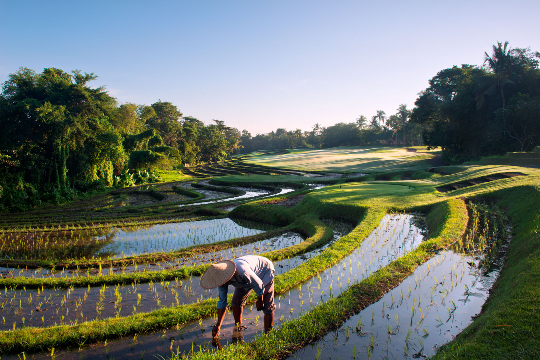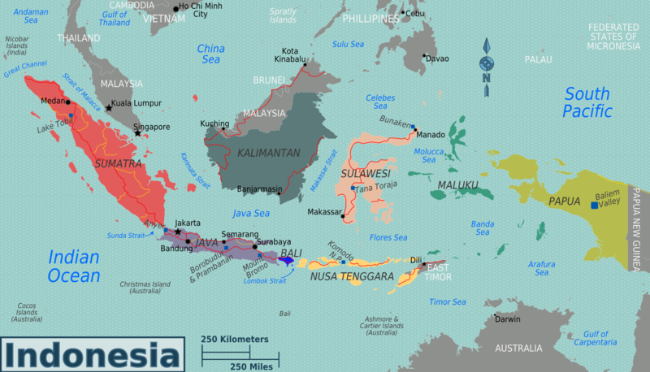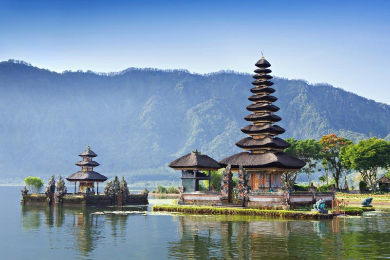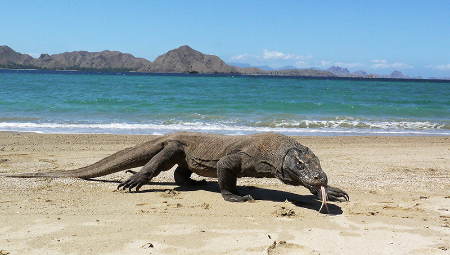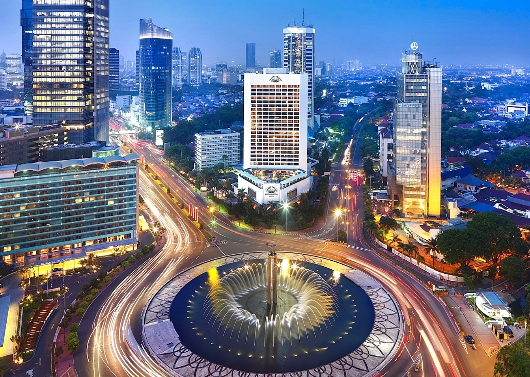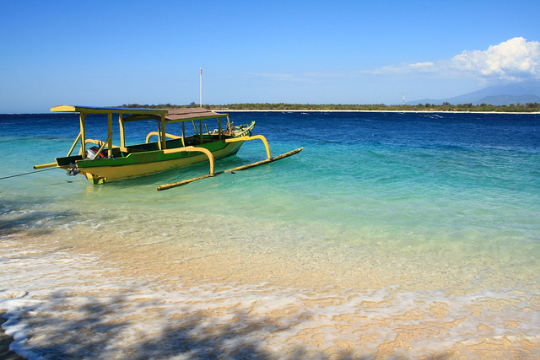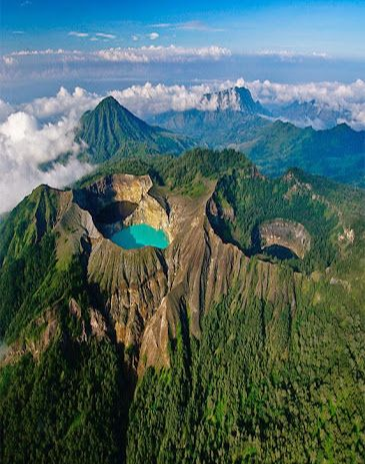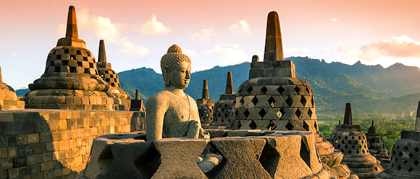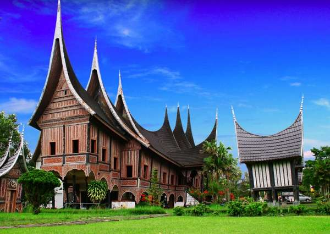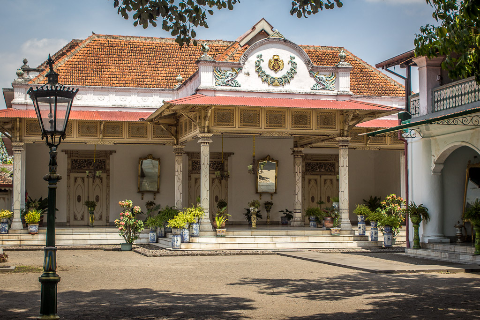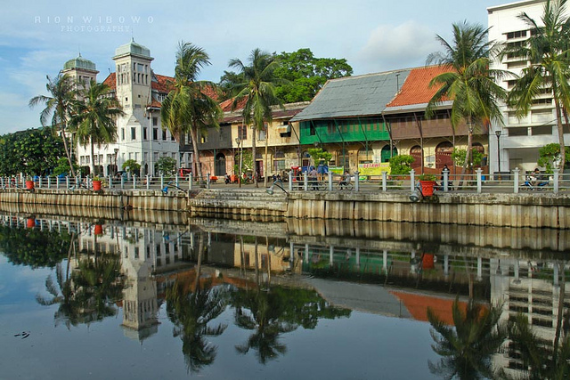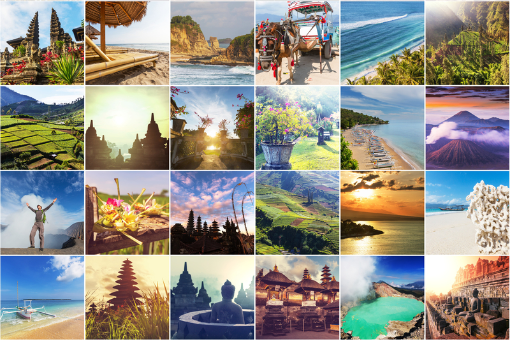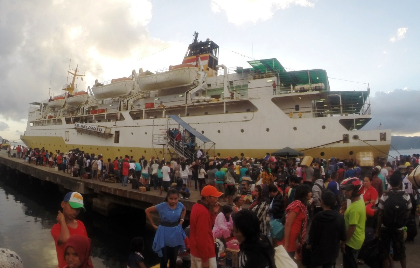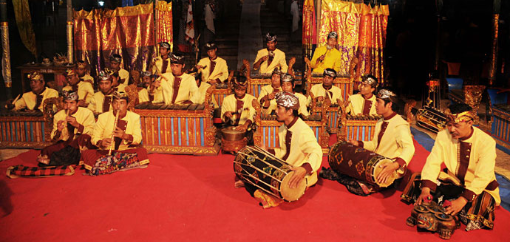Featured Country: Indonesia
Discover a fascinating and mega diverse South East Asian island nation and travel there with your ears through its varied music styles
Related Features:
- Focus on Indonesian Reggae in the World Reggae page here
- Featured Artist Indonesian Reggaeman Ras Muhamad in the World of World Music page here
- Links on Indonesian travel, music and culture in the Links & Services page here
A selection of the different styles of music, from traditional to modern, found throughout the Indonesian archipelago
The South East Asian nation of Indonesia, the largest island nation in the world with over 17,500 islands stretching over 5,000km from east to west and almost 1,800km straddling the equator from north to south, is also the world's fourth most populous country with over 258 million inhabitants, of which some 88% are Muslims, making Indonesia the largest Muslim majority nation in the world.
With about a third of the islands being populated, the main demographic concentration is on the island of Java, home to about 58% of the total population and to Jakarta, the country's economic and political capital and by far Indonesia's largest city with around 10 million people.
This makes Java the world's most populated island. Indonesia also shares the island of New Guinea, the second largest in the world, with Papua New Guinea; the island of Borneo, the third largest in the world and only one shared among three countries, with Malaysia and Brunei Darussalam, and the island of Timor with Timor Leste.
The country's diversity is not only geographical, with features such as dense rainforests, volcanoes, lakes - some with islands inside lakes, cool highlands, steamy lowlands, mountain peaks and a myriad of islands of all types, but also cultural, ethnic, religious and linguistic, with some 300 distinct ethnic groups, mainly from Austronesian and Melanesian origin, conversing in over 700 different languages and dialects, often in addition to Bahasa Indonesia, the national language.
Though Islam is the majority religion, religious freedom is guaranteed in the Constitution, with sizeable Christian minorities, as well as Buddhists, mainly from the Chinese community, and Hindus found mostly on Bali.
Traditional animistic and shamanistic beliefs still exist in some areas with ethnic minorities, but often co-exist alongside the main religions or influence them, with most people practicing a syncretic form of their religion that draws on local customs and beliefs, which explains why by and large there is much tolerance and peaceful coexistence among the multifaceted population living under the national motto of 'Unity in Diversity'.
From uncontacted tribes in remote areas of West Papua and Papua provinces (formerly known as Irian Jaya) on New Guinea island, to the Toraja people of Sulawesi who consider death a sickness, the gentle and highly mystical Balinese who observe once a year Nyepi - a 'Day of Silence' when all activities come to a halt on the Island of the Gods, the Dayak tribes of Kalimantan (Indonesian Borneo) whose ancestors were often renowned as headhunters, the refined and aristocratic Javanese of Yogyakarta - often considered the centre of Javanese culture, the culturally distinct Batak people of North Sumatra, the Mentawai people of the Mentawai islands of Sumatra, to the modern urbanites of bustling Jakarta and many, many more around the sprawling archipelago, the peoples of Indonesia constitute a fascinating kaleidoscope of cultures, languages, religions, traditions, cuisines, costumes, crafts and of course music that offers endless fascination to visitors and scholars alike.
And if that geographical and cultural diversity was not enough, Indonesia is also one of the 17 megadiverse countries identified by Conservation International, only second to Brazil in terms of biodiversity, and second only to Australia in terms of endemic species found on the nearly 2 million square kilometres of its land mass and vast coastal environments.
With the Wallace Line separating the Asian and Australian faunal eco-zones where the ancient glacial era shores of both continents were separated by open seas, the diversity of animal and plant life, on land and in the water, is simply extraordinary. From tree climbing kangaroos and rare egg laying mammals (echidnas) in the Papua region, prehistoric looking 'dragons' found on Komodo, Flores and a few other islands, majestic Sumatran tigers, bizarre looking long-nosed proboscis monkeys on Borneo island to the iconic and endangered orangutan found on Borneo and Sumatra islands, animal lovers have plenty to look forward to when visiting Indonesia. This mega diversity extends as well to plants, insects, butterflies, reptiles, frogs, coral and other marine creatures, making the archipelago a must see destination for nature lovers.
Humans and their ancestors have been present in Indonesia since the first hominid migrations out of Africa nearly 2 million years ago, while in most recent times, when most of the archipelago was during the last ice age part of the Sundaland continent that linked it to Europe and Africa, it served as a transit point to the people who went on to inhabit the Australian continent and the Melanesian islands of the South Pacific. In most of the archipelago, these early populations were gradually supplanted long after the end of the ice age by Austronesian groups, who navigated between what had become islands and introduced rice farming.
In more recent history, Hindu and Buddhist kingdoms, such as the better known Sri Vijaya and Majapahit kingdoms, ruled over parts of the archipelago and often beyond in the Malayan peninsula, with naval regional and international trade as dominating activities, which brought at first Muslim traders, starting the gradual islamization of the archipelago from around the 13th century onwards, and then European powers vying to dominate the lucrative trade in spices.
The Portuguese were soon followed by the Dutch, who became the dominant power in the archipelago, with most of it falling under their colonial influence until the Japanese occupation during the Second World War, which was followed after liberation in 1945 by a unilateral declaration of independence establishing the Republic of Indonesia. After years of autocratic rule by presidents Sukarno and Suharto, Indonesia is now on a firm democratic path with a fast growing economy based on a strong industrial sector, vast reserves of natural resources and a vibrant tourism industry with the potential to grow much further.
Travel and tourism in Indonesia
Describing all that the country has to offer for visitors would take volumes, so for a more detailed overview it is best to check the links page, but there are mainly three reasons to visit Indonesia: sea and sun, nature and culture.
For sea and sun seekers, the island nation has abundant offerings, from well-known Bali, easily accessible Bintang and emerging Lombok, where international resorts can be found along gorgeous beaches with all traveller comforts available, to myriad other choices among thousands of islands for those willing to explore further.
Divers should head primarily to northern Sulawesi for the Bunaken National Park, considered among the world's best diving sites, while among many other dive spots the Gili islands off Lombok are perfect for beginners and the Raja Empat islands in West Papua will offer to the more adventurous some of the richest marine life anywhere on Earth.
Surfers will find no shortage of great waves to catch. From the well-established spots in Bali and Lombok to the Nias and Mentawai islands off Sumatra and plenty more places to discover, Indonesia is most definitely a surfers’ paradise. Adrenaline seekers can go looking for other thrills as well, with mountain biking, rafting, para sailing and many other land and water based activities available in the many resorts or on expeditions to remote areas.
With a number of national parks and all the above mentioned flora and fauna diversity, dense rainforests and animal sanctuaries, nature lovers could spend months visiting the many areas of ecological interest, as well as those of stunning natural beauty such as for example the active Mount Bromo volcano in eastern Java, the three coloured lakes of Mount Kelimutu on Flores or the enormous Lake Toba in Sumatra, to mention a few of the breath-taking sights awaiting visitors to this island nation.
It is however those interested in the cultural aspects of the archipelago who will find the most dizzying variety of traditions and ways of life. There are communities living at arm's length of modern society, such as various tribal groups in Papua province or in the Mentawai islands off Sumatra, some distinct but integrated cultural minorities such as the Dayak (a generic term encompassing several ethnic and cultural groups) of Kalimantan, the Toraja of Sulawesi or the Batak of Sumatra, and many more interesting groups such as the Hinduistic Balinese, the matrilineal Minangkabau of West Sumatra or the religiously conservative Acehnese of Northern Sumatra, alongside Javanese, Sundanese, Madurese, Bugis, Malays and hundreds more. In addition to ethnic and cultural affiliations, there is an Indonesian national identity that most in the archipelago subscribe to, especially in the capital Jakarta and other big cities, where groups intermingle socially or at work, where there is a stronger Chinese community presence and where global cultural influence is strongest.
Besides experiencing the living culture of traditional and modern Indonesia, travellers can also enjoy some spectacular and interesting man-made structures. Welcoming the rising sun from the top of Borobudur, the world's largest Buddhist temple dating from the 9th century and located in Central Java, is an unforgettable experience. Nearby, the impressive Hindu temple complex of Prambanan is a reminder of Indonesia's pre-Islamic past, while the many Balinese temples and palaces, where religious and cultural ceremonies are regularly held, reminds us that Hinduism is still present in the country.
Traditional architectural styles of the different ethnic groups can be at times spectacular. Some are preserved as cultural heritage, as museums or as tourist attractions, while many are still in use as private dwellings, visitor accommodation or communal and official buildings.
The 'large houses' of the Minangkabau of West Sumatra, with their buffalo horn shaped roofs are probably the most visually impressive, as are those of the Toraja on Sulawesi, while equally interesting are the houses of the Batak in North Sumatra, the traditional 'longhouses' of the various Dayak people of Kalimantan and so many more from the different islands, all shaped by culture, traditions, superstitions, religion, the environment and the materials available, making vernacular architecture and the traditions, lifestyle and living culture associated with it another reason, if needed, to visit this fascinating country.
With Islam having centuries of presence in the archipelago and being now the majority religion, it has however blended with the local culture and styles of the different ethnic groups that came under its influence, with this being visibly reflected in the eclectic, intriguing and sometimes bizarre collection of Keraton, the palaces of the various Sultanates that flourished across many of the islands since the advent of Islam, a few of which are still in existence today having reached accommodation with the central power in Jakarta, and Mosques, from small village ones to the main one in Jakarta, one of the largest in the world, with some of these buildings looking as if straight out of a 1001 nights tale and providing great material for photographers or architecture buffs.
There is of course a wide range of Dutch and Portuguese colonial architecture across the country.
Not to be missed when visiting Jakarta is Kota Tua or Old Town, which is where Batavia, the capital of the then Dutch East Indies, was located. A number of fine buildings have been restored, and within Old Town, the Glodok area- Jakarta's Chinatown, is of interest, as well as Sunda Kelapa, the old port of Batavia, now plied only by the traditional Pinisi sailing ships that still carry a good portion of the inter island trade.
Not far from Jakarta is Bandung, the country's third largest city and where the famous Bandung Conference was held in 1955. Being nearly 800 meters above sea level and enjoying a milder climate, the city was favoured by the Dutch colonialists and boasts a number of buildings from that era, including some fine examples of art deco architecture. There is of course plenty of modern and glitzy architecture in the big cities, especially Jakarta, where a cosmopolitan crowd mingles in shopping complexes, gourmet restaurants, art galleries or the many lively night life venues.
One of the attractive features throughout Indonesia is that many of the places of accommodation, from backpacker catering Losmen (the Indonesian version of B&Bs, Motels and Hostels) to über luxurious and refined boutique hotels, as well as some of the branded international resorts, make use of those charming vernacular architectural styles, either when building new properties or transforming existing houses or palaces into losmen, hotels and resorts, giving a strong sense of place for the guests staying there.
Reaching and traveling through this incredibly diverse destination and accessing its places of natural or cultural interest is relatively easy for the main centres, demanding perhaps some additional efforts for the more remote and less travelled areas.
Citizens of most countries do not require visas for leisure trips lasting less than 30 days, and can enter through more than 120 authorized entry points. International flights from Europe, Australia, Japan and the Middle East fly regularly to Jakarta and Bali. Regional flights, mostly from Singapore or Kuala Lumpur, and a few from the Middle East, cover also some of the main secondary destinations. Those from the Americas, Southern Africa and other places not directly connected can best reach the country through hubs such as Dubai, Hong Kong, Kuala Lumpur or Singapore. There are ferries from Malaysia and Singapore to a few ports in Sumatra and to the Batam and Bintang islands near Singapore, as well as land crossings with Malaysia between Malaysian Borneo and Kalimantan, with Papua Niugini and with Timor Leste.
Once in the country, a number of national and local airlines link most of the islands, making travel by plane the most practical mode of transport. More romantic however and relevant in such a large archipelago is travel by sea, with all kinds and sizes of craft plying routes between the islands and giving a chance for travellers to see the country at a slower pace, get to know the locals and gain a better understanding of the country and people. Within the islands, buses, minibuses and motorcycle taxis move passengers and cargo around, while train buffs can enjoy train services across Java and most of Sumatra.
Visiting such a vast country requires time to really appreciate it. If short on time, it is best to concentrate on an island or two, depending on interests, as inter island travel, though interesting, can be time consuming. From Banda Aceh in North Sumatra to Merauke in Papua, Indonesia is practically a world on its own, with more to see, do and experience than most other places on Earth. Generally safe for visiting tourists and welcoming of foreigners, like any other countries, Indonesia has its share of problems, from deforestation, pollution, poverty and inequality to political tensions, separatist movements in Papua, the occasional flaring of communal violence and threats from religious extremism, though not to a level that should discourage travellers to discover this fascinating island nation.
And then there is the music, in all its glorious and mind boggling diversity of styles and musical instruments used to produce it. Whether vernacular from the different ethnic groups and tribes from Sumatra to Papua, common to South East Asia, with Indian, Arabic, Chinese or Western influence, invented or modified in modern times, and whether bronze gongs, percusions, wind and stringed instruments, made of wood, bamboo or metal, just describing them all would take volumes.
From courtly and refined Gamelan music to low brow and popular Dangdut, through romantic and lively ethno pop tunes from the various regions and a rich local reggae scene, as background to elaborate dance performances, to the music behind the enigmatic Wayang Kulit (shadow puppets) plays or powering village parties and dance halls, as well as being celebrated in a number of festivals and celebrations, music is an ever present feature of life in Indonesia and the music lover travelling through the archipelago will have rich pickings in any of the islands...or alternatively while planning such a trip, can enjoy selected videos and playlists below on this page and through the different sections of the Travel With Your Ears™ website, while learning more about the country, its culture and music in the Links & Services section. Let the music take you places and enjoy your musical journey through Wonderful Indonesia.
Indonesia Destination Videos
Beautiful images, beautiful music, beautiful country, beautiful people and beautiful culture...an invistation to visit Wonderful Indonesia
Raja Ampat islands in West Papua province, one of many diving paradises across Indonesia
Tanjung Puting National Park in Central Kalimantan, where the Orangutan Foundation's Camp Leakey can be visited
A stunning visual invitation to discover the diversity of cultures and traditions of Wonderful Indonesia
Music Videos from Indonesia
Jangi Janger by Puspa Dewi, a soothing Balinese folk song reflective of traditional Indonesian music, though in reality the country's musical styles are as diverse and fascinating as the rest of the archipelago, from very traditional to pop, reggae and regional styles
Gandrung Gunung, a Kecapi Suling (zither and bamboo flute) traditional melody from the Sunda region in West Java, Indonesia
Madu Dan Racun by Bill & Brod, a classic 70s era ethno pop Indonesian song that hasn't lost any of its freshness
Kang, Teu, Wekak by Alfred Gare, a lively Joget from the beautiful island of Flores in the Nusa Tenggara region
Bolelebo by Natalino Mella, played on a modern version of the Sasando, a unique string instrument from West Timor
Papua Dalam Cinta by Pay and Soa Soa, from the Papua region, the Indonesian half of New Guinea Island
A spirited outdoor buskers' performance featuring a re-arranged version of the traditional Angklung bamboo instrument
Mawar Bodas by Detty Kurnia from Indonesia, sweet sounding Sundanese modernized traditional song
Balinese Music and Dance exquisitely refined performance at the Royal Palace in Ubud on Bali Island, Indonesia's top tourist destination
Brother & Sister by Boys n Root, a fine example of the vibrant reggae scene in Indonesia (check the World Reggae page for more)
Sajojo, a traditional song and popular dance from Papua, illustrated with photos from this interesting and little visited region
Mabok Bae, a classic Dangdut Koplo song from the early 2000s by Inul Daratista, famous for her sometimes controversial on-stage gyrations
Denpasar Moon by Merry Andani, a Dangdut song about Bali, Indonesia's most famous and visited destination



























